Piero Incisa della Rocchetta comes, for those who know nothing about wine, from one of the most famous families of wine producers who launched Tenuta San Guido in Bolgheri, Tuscany, and made it a success. When years ago he talked for the first time to his importer in England of a new Pinot Noir wine, the reply he got was: «I had no idea you had bought some vineyards in Burgundy!». Piero then told him that no, he wasn't making it in France, but in Argentina; and the English importer, a mix of surprise and disappointment, started to laugh. Without considering who he was talking to, and whose steps that wine producer from north Maremma was following when presenting a wine from a noble grape variety from France, but made in a very different terroir. Perhaps he didn't know, or he didn't think at the time, that Piero had always been taught, not only to tell a great wine, but also to be curious, to experiment, and think out of the box. The genius of grandfather Mario has found in his grandson, like Cabernet Sauvignon in Maremma and, apparently, Pinot Noir in Patagonia, a fertile soil that can give exceptional results.
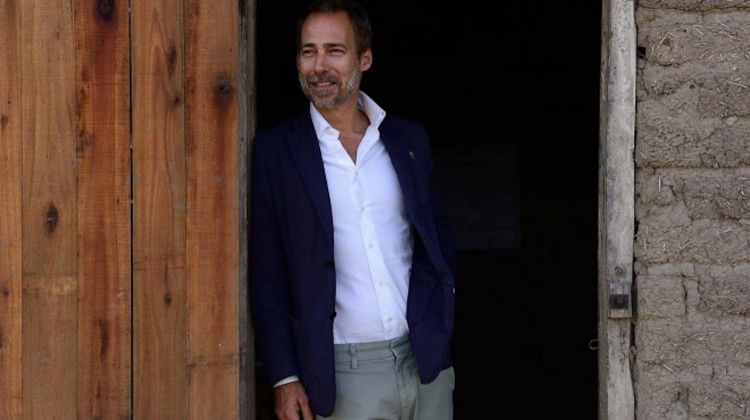
Piero Incisa della Rocchetta
Indeed, it's a long way from Bolgheri to Patagonia. How, when and why Piero ended up in the remote region of Rio Negro, is a topic we discussed with him a few days before he left for Argentina – not without difficulties, given the restrictions caused by the Covid-19 emergency - where, on the 9th of February he started the 2021 harvest of the white grapes.
The special affinity with Pinot Noir dates back to some very early tastings with his grandfather: «I would always drink it with him – he said – It's a very seductive grape variety from which the French have made some of the most prestigious and expensive wines in the world». The French, indeed: so we should pardon the importer.
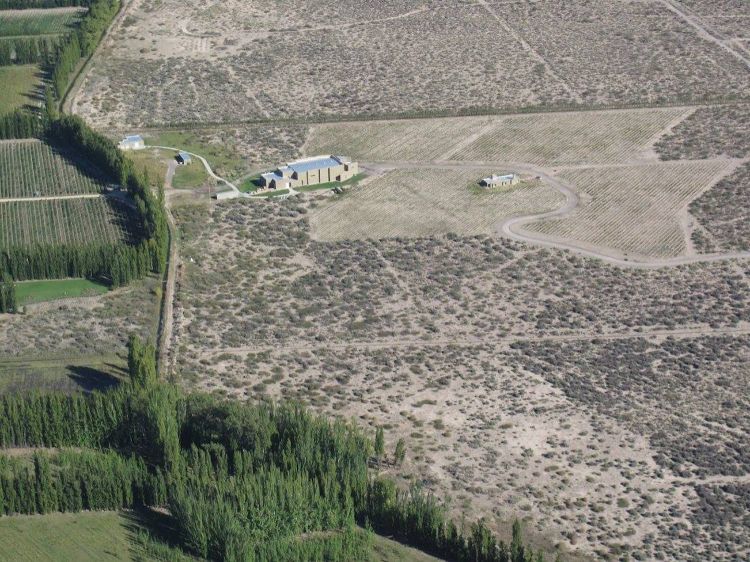
Bodega Chacra seen from above. You can notice the Patagonian Desert, swept by the wind, and the green vineyards, protected by the lines of poplars planted by Piero
IHe arrived in Patagonia because of a tasting in New York, in 2001: a blind tasting of Pinot Noir from different parts of the world. Only one, out of all the wines tasted that day, struck him: «It wasn't exceptional – he explained- but it had the characteristics I'd been looking for a while: very strong fruit, and a floral character». Indeed it was a wine produced in this Argentinian region, extreme in terms of location and climate
. In 2002
Piero is already in Patagonia to inspect the region, looking for vineyards to buy. Here he discovers that these places have an exceptional genetic heritage: plants over 130-years old, ungrafted, planted by some Italian and Spanish immigrants during the previous century, and which have stood, over the decades, the test of peronospora, oidium, moths and phylloxera thanks to extreme climate (and in spite of it and adapting to it): a very strong and dry wind, that comes from the Andes; the natural barrier of the surrounding desert; an arid climate (only 150 mm of rain each year); very high day temperature and very low night ones, with a daily difference, as typical of this climate, of up to 40°C. A place untouched by pollution, kissed by exceptional and pure sunlight, touched by the uncontaminated waters of the rivers Limay and Neuquèn that descend from the Andes: they later converge into the Rio Negro, which cuts this region. Next to this river, in the early 19th century English immigrants built a system of canals that to this day allows to water the plants with precision, and which in time has led to creating a green belt on the banks.
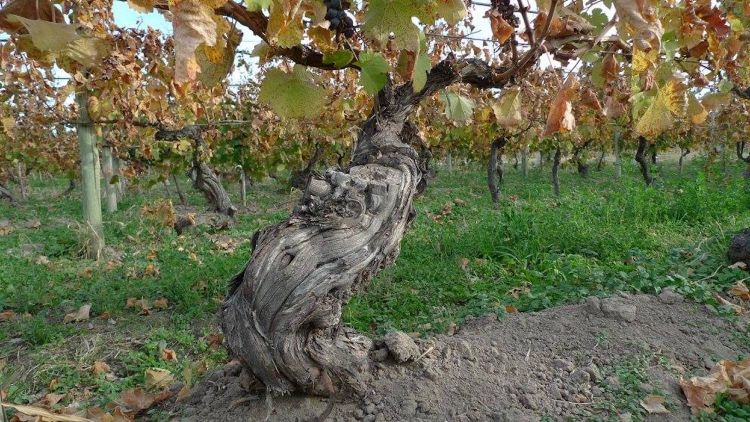
The ancient vines at Bodega Chacra. An exceptional genetic heritage that has adapted over the decades.
A place that had, in the words of Piero, a «huge energetic power».
Three years after that first tasting in New York, in 2004, Piero Incisa della Rocchetta had already bought the first vineyards, all ungrafted, the eldest of which were around 70 years old. They had been planted in 1932 though it's unsure by whom and why, and today they give life – and inspire the name – to the wine that Suckling has placed at the top of his Top 100 Wines of 2020 list: Chacra Pinot Noir Patagonia Treinta y Dos: “Treinta y dos” refers to the year when these vineyards were planted.
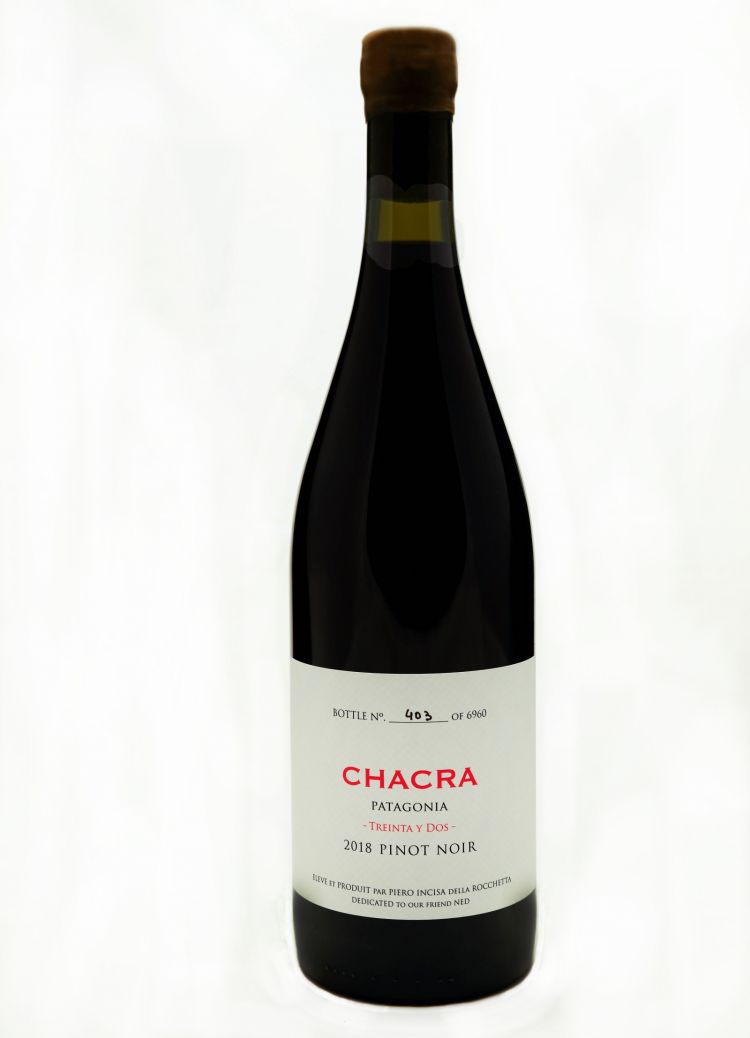
Chacra Pinot Noir Patagonia Treinta y Dos. The 2018 vintage got 100 points from James Sucking and the first place in his Top 100 Wines of 2020, as "wine of the year"
To reach Bodega Chacra, you must take a three-hour flight from Buenos Aires to Neuquèn, and from there drive until Mainque, the closest town. The estate is almost equally distant from the Andes to the west, and the Atlantic Ocean to the east, and spreads over 1000 hectares - «It's the equivalent of half a hectare in Chianti»Piero explained, given that 80% is covered by the typical Patagonian desert bush. The vineyards spread over some 40 hectares, mostly of Pinot Noir and a small portion of Chardonnay, planted later.
The climate is perfect to grow fruits, which is indeed the main economic activity of the region. The word chacra, in south Argentina, refers to a plot dedicated to orchards, especially pears and apples. When you buy pears out of season, from Argentina, it's very likely they were produced here, in the chacras that thrive on the green belt on the sides of the Rio Negro. But the word "chakra" (with a "k"), according to the Hindu doctrine, also refers to the points of vital energy distributed on our body which allow us to connect with the rest of the universe, a doctrine that deeply inspired Rudolf Steiner, the founder of biodynamic farming. Wine is food, not only for our body but for all of our senses, and “Bodega Chacra aims to enhance this connection”, according to the website. According to Incisa della Rocchetta's vision a farm is a complex living being whose balance and development are based on the relationship between soil, plants, and animals. People are part of this balance: they must respect it, firstly, and then observe in which way their actions affect the environment while trying to preserve and foster this balance with actions that are not dictated by pre-set protocols but suggested by experience and first-person observation.
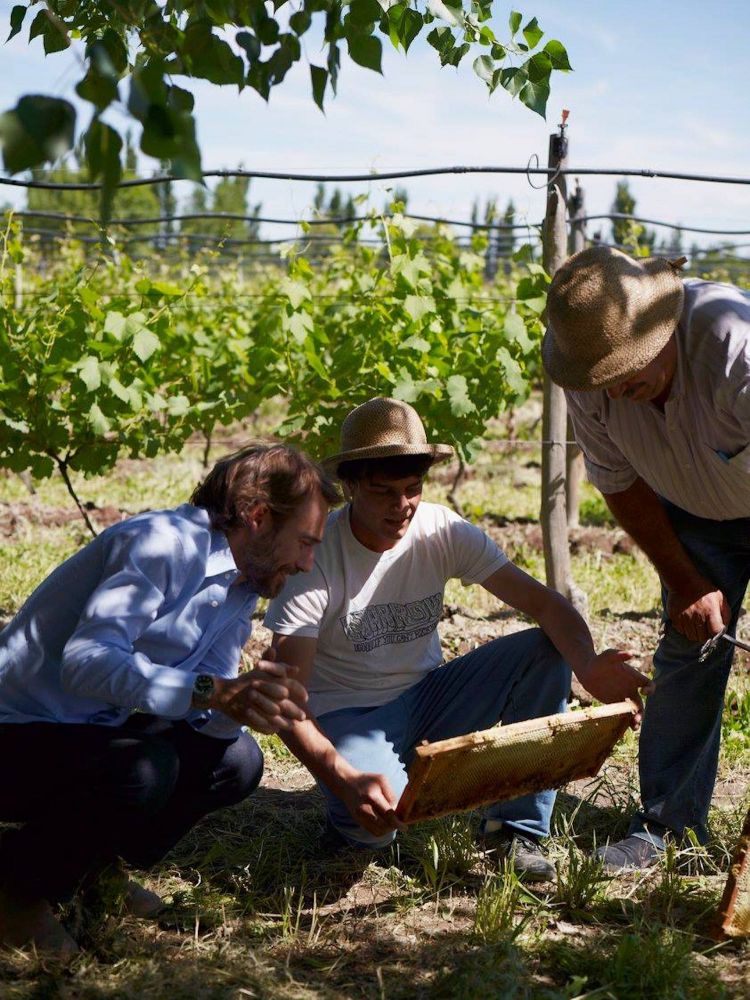
Piero Incisa della Rocchetta with two beekeepers at Bodega Chacra. The synergy between viticulture and beekeeping is widely acknowledged. Bees give a crucial contribution to biodiversity, for the benefit of the vines, the health of the grapes and the quality of the yeast on the peel
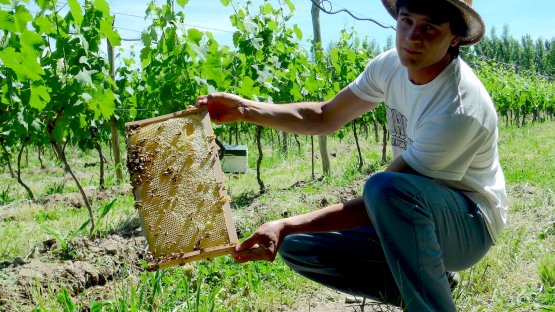
Bees have a crucial role at Bodega Chacra and, in general, in biodynamics applied to viticulture
In the winery, on top of the 22 hectares of Pinot Noir and 16 of Chardonnay, there's space for an animal farm (sheep, goats, hens, ducks, pigs, horses…), beehives with precious bees, an area for the production of organic compost (300 tons per year), the vegetable garden where they grow tomatoes, aubergines, beetroots, pumpkins, herbs. You can smell roses, lavender, camomile, equisetum, nettles, valerian: which help reinforce the immune response of the plants and create organic compost. The bark of the oak trees is used to nourish the soil, and the poplars – over 35K trees planted in two lines by Piero – serve to soften the strong winds that come from the Andes, and improve the drainage of the water in the soil, as well as offer some shade from the merciless summer sun of Patagonia [not everyone knows that the famous cypress trees in the poem by Carducci in which he mentions Bolgheri, were meant to be poplars].
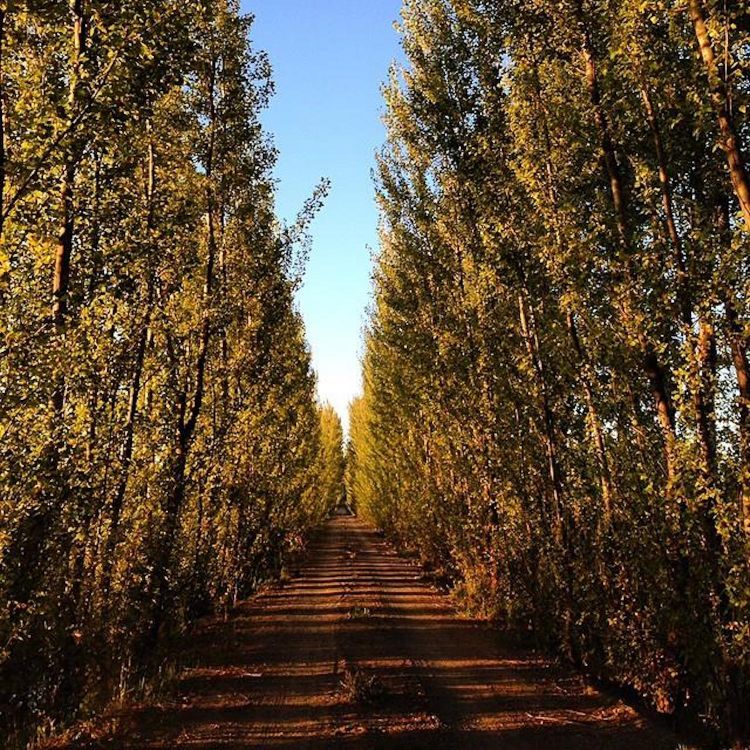
The lines of poplars planted by Piero
Piero's goal, when he started planting Pinot Noir here was not just to make an exceptional wine, but also to produce an interpretation as free and transparent as possible of the place, the climate, the microclimate, and the terroir of Mainquè. The choice of doing so following organic and biodynamic farming «was the only one that made sense», he said. Why so? Because there's no need to use chemicals: «If you need chemicals for farming, it simply means you're doing it in the wrong place».
This doesn't mean you can just be idle and leave everything to nature. Quite the contrary: the work in the vineyard is meticulous. You need to be always vigilant and strict. There's nothing “natural”, Piero points out: behind a biodynamic wine there's plenty of work, lots of research, empirical observation, study and endless decision-making: «I am there, I take my risks all the time. You must be careful and humble to preserve and re-establish the balance when you notice you've lost it». The absence of predefined protocols of course implies more work and risks, it makes it harder to manage all the variations in the games. The line between success and failure is very thin, sometimes, he told us.
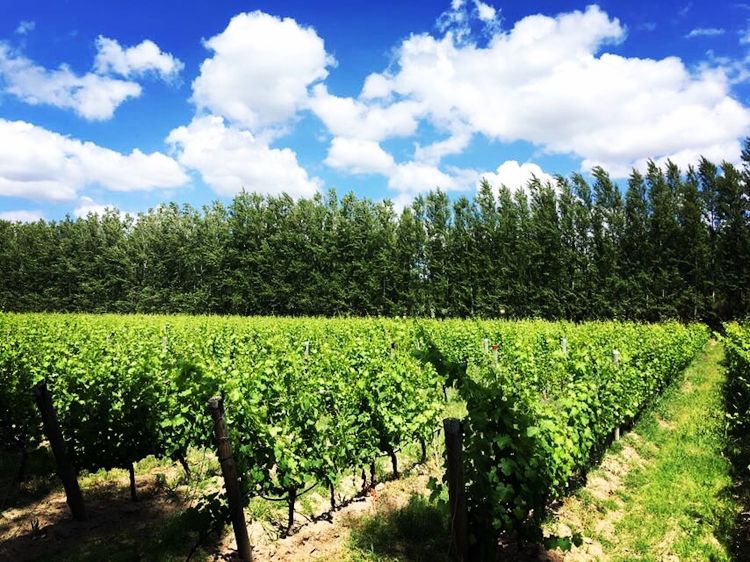
Piero's goal, when he started planting Pinot Noir here was not just to make an exceptional wine, but also to produce an interpretation as free and transparent as possible of the place
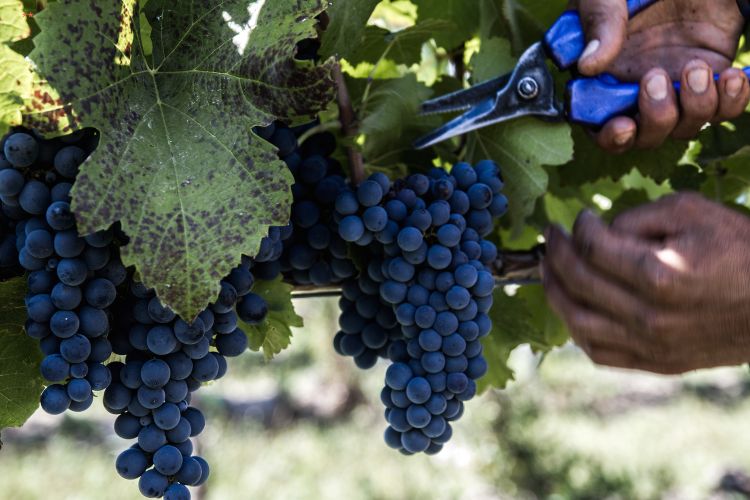
The harvest of Pinot Noir started on the 12th February: a very early harvest, so that the grapes showed a magnificent acidity
The result, in the words that James Suckling used to describe the Pinot Noir from Bodega Chacra: is a wine that strikes thanks to its from the merciless summer sun of Patagonia [not everyone knows that the famous cypress trees in the poem by Carducci in which he mentions Bolgheri, were meant to be poplars].
Piero thinks the fact the wines can be enjoyed soon is very important: «Great wines can be approached even when young. Of course, sometimes it's interesting to wait, but they must be good right away. That's what my grandfather also told me. In this sense, our wines are "digestible", they're very drinkable».
This feature is a result of the work done in the vineyard and in the cellar. The maceration takes place in round tanks, very shallow (around 1 metre high) and very wide (around 2 -2.5 metres of diameter). This so that the skins can have as much contact as possible with the must: the wine is not made through extraction but infusion, and so the peel can release its phenolic components giving elegance and balance, without too strong extractions. After the (spontaneous) fermentation with indigenous yeast in cement tanks, the ageing takes place in cement and very fine and lightly toasted French oak barrels (used once, twice and three times): «We don't want to give an excessive cosmetic appearance to the wine».
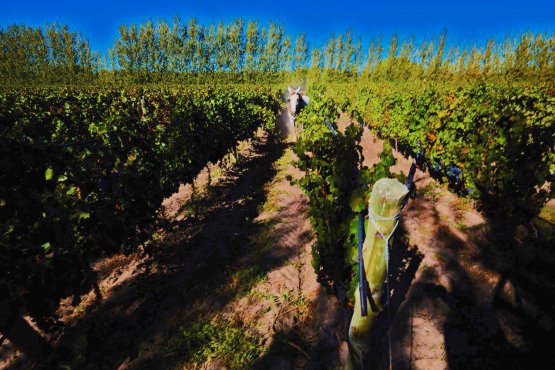
The analysis of each plot, the careful mapping to understand if and which substances are lacking in the soil, so that they can then be added through specific plants. Bees, hens, sheep, horses, the vegetable garden, the herbs, the oak and the poplar trees… Everything contributes to preserve and enhance the balance at Bodega Chacra
Today Bodega Chacra produces some 150 thousand bottles and 8 different wines. It's a modern and healthy winery, an agricultural business with large margins, where the demand of products exceeds the production by 60% at least. All the profits are reinvested each year (a choice that is also explained by Argentinian inflation, which is around 30%) and distributed to the employees. «You can run an organic and biodynamic farm and have a flourishing business» Piero points out. And he hopes, he confesses, to inspire other producers too.
Even Suckling, in his review, admits he has chosen the wine not only because of its excellent features, but also as a virtuous example worth following:
It's a marvellous wine, not only because it's a wine that deserves 100 points, but because it represents a series of features we appreciate in today's wine production, especially in these times of climate change and economic instability: an incredible value, an environmentally friendly production, a neat character that mirrors its ecosystem, and an incredible drinkability. Chacra Pinot Noir Patagonia Treinta y Dos 2018 from Argentina is an emblem of all this and much more, and this is why it's our top wine in 2020.
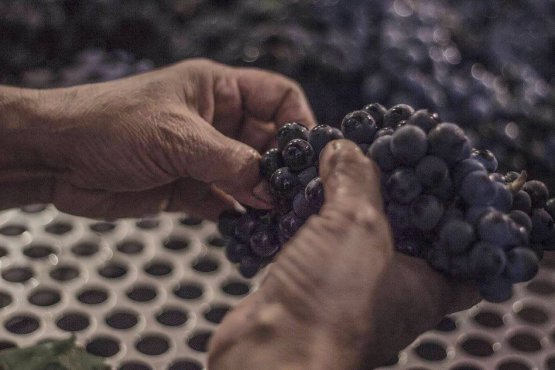
Manual selection of the grapes
The attention and commitment in safeguarding the environment is one of the many things that Piero has inherited from his brilliant grandfather Mario who was among the founders and the first president of the WWF in Italy. «He was a brilliant man, extremely intelligent, who lived all his life experimenting – the grandson recalls with deep admiration. – One of his most precious lesson I learnt from him is that we have some great duties and that these come first, before any personal and egoistic need».
Translated into English by Slawka G. Scarso